The Mark Morris Dance Group performs in its own Brooklyn space.
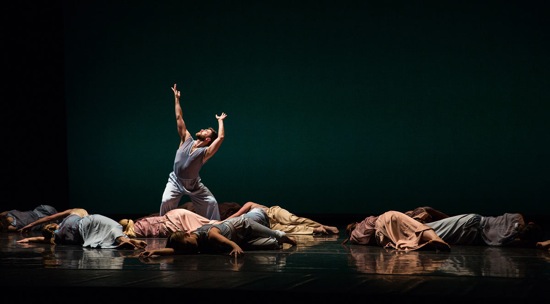
Sam Black and the Mark Morris Dance Group in Morris’s The. Photo: Mat Hayward
Music often takes Mark Morris in directions I couldn’t have anticipated, as the programs for his company’s season at the Mark Morris Dance Center make clear. Only occasionally does a score’s history enter the picture, and, if it does, it enters with an enigmatic twist. His 2005 Cargo is set to Darius Milhaud’s La Création du Monde (composed for Rolf de Maré’s Ballets Suedois in 1923), with its allusions to African creation myths and the jazz that the composer had travelled to the U.S. to hear (among the seventeen instruments—winds, brass, strings, piano, and percussion—is an alto sax). Blaise Cendrars had drawn a scenario for choreographer Jean Börlin from his own 1921 Anthologie Négre,
Morris’s vision of the music’s six sections is more primeval. His nine dancers, wearing plain white underwear, swing along like monkeys, crouching and squatting warily as they approach a pole lying on the floor. They’ve never seen anything like this before. They hesitate to touch it. One man smells it. Pretty soon, a game (tilt the pole, let it fall, someone else has to catch it) turns into a ritual (seated in a chain—with every other person facing the opposite direction from his/her neighbor—they hold the pole horizontally, lifting and lowering it as they lie down, sit up, and twist to one side or the other).
The pole and two more that appear determine these created-on-the-spot rituals. Domingo Estrada, Jr. extends one horizontally. You can see it as both phallic symbol and the stake in a tug-of-war; the others take turns stroking their hands along it, but also, perhaps hope to pull it away from him and get his job. Three of the women erect a triangle with the three poles and stand within it; anyone who rushes to grab for it gets knocked away. Although the members of this tribe exhibit their naiveté, Morris has refined and abstracted their customs. Several times Lauren Grant may be hanging by her elbows or her knees from a pole carried along by two men, but one time she rides it sitting up and looking imperious. From a victim or the carcass from a successful hunt, she becomes a queen borne along by her flunkeys. Still, in the end, when a tilted pole drops with a sharp noise, the last note of the music cuts out, and everyone runs away in terror.
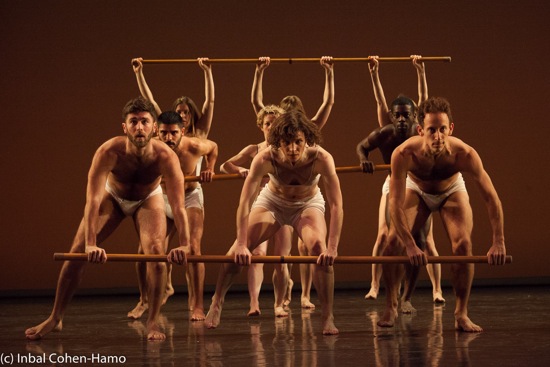
Mark Morris’s Cargo. (front row, L to R): Sam Black, Laurel Lynch, Aaron Loux; (middle row): Domingo Estrada, Jr., Lauren Grant, Brandon Randolph; (third row): Rita Donohue, Jenn Weddel, Lesley Garrison (hidden). Photo: Inbal Cohen-Hamo
The music for Morris’s 2002 Foursome is a combination of Erik Satie’s Gnossiennes #1, #2, and #3, written in the 1890s, and Johann Nepomuk Hummel’s Seven Hungarian Dances, composed between the late 18th century and the early 19th. Who but Morris would think of juxtaposing these piano pieces from different eras?
Although the instrument that the excellent Colin Fowler plays sits at the back of the performing area, what the choreographer has drawn from the music is a sense of the open air and four comrades dressed in sports clothes (Estrada, Dallas McMurray, Billy Smith, and Noah Vinson) strolling along together, first to the sparer Satie music, then getting more and more intricately playful to Hummel’s slightly denser pieces, and ending back with Satie. The Gnossiennes have a delicate aura of nostalgia, and occasionally Hummel, whose roguishly energetic dances speed up as they go, writes something ruefully sweet, even, almost, a lullabye.
Morris employs some charming strategies, for example having one guy dance up to another and set him in motion, and so on, as if this were a game of tag with no running or touching, just a “your turn now.” The men show their sensuous enjoyment of the music, but they’re ready to kick out boisterously or stamp emphatically. They dance in twos—Vinson and Smith, Estrada and McMurray—and all at once, and never lose that sense of inhabiting a golden afternoon: its dreamy strolls, its playful eruptions, its easy camaraderie.
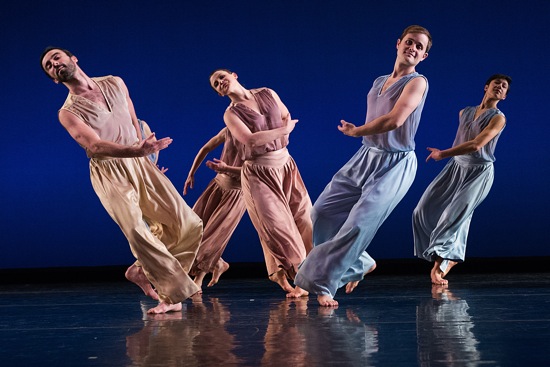
Mark Morris’s The. (L to R): Brian Lawson, Nicole Sabella, Dallas McMurray, Stacy Martorana. Photo: Mat Hayward
The superb dancers who bring these two works to life are joined by the rest of the company for The, which premiered last summer at Tanglewood. Here the glorious music is J.S. Bach’s Brandenburg Concerto No. 1 in F Major in Max Reger’s arrangement for piano four-hands (played at these performances by Fowler and George Shevtsov). Morris doesn’t seek to capture the early 18th-century atmosphere that prevailed at the court of the Margrave of Brandenburg-Schwedt, to whom Bach dedicated a work that soars through the compositional conventions of the time. Those dancers who, earlier in the evening, lurched and crawled or acted the part of sportive pals enjoying the country have become part of a throng of angels dancing in a lusty heaven. Since in the Martha and James Duffy Performance Space, the spectators sit close to the dancers and the pianists, we’re there too.
Wearing billowy pants and tops in pale blue, rose pink, or beige (designed by Elizabeth Kurtzman), the sixteen dancers seem airborne much of the time; they jump and kick and beat their feet together (they also do oddly interesting things like lying on the floor and making their fingers take a walk along it). The choreography also emphasizes the full ways in which the dancers use their torsos—bending and arching and twisting as their feet go busily along. In this rich dance with its enigmatic (if assertive) title, they come and go, form quartets, take solos, entertain or help one another, swarm, drop it into unison, engage in movement dialogues (Estrada and Brian Lawson look as if they might meet in friendly combat, but decide to play tag of a sort instead). Sam Black holds a long balance on one leg, amid others who have fallen to the ground. And all these actions respond fluently to what Bach has created—formally astute yet making the dancers look as if they were indeed at play in Elysian fields.
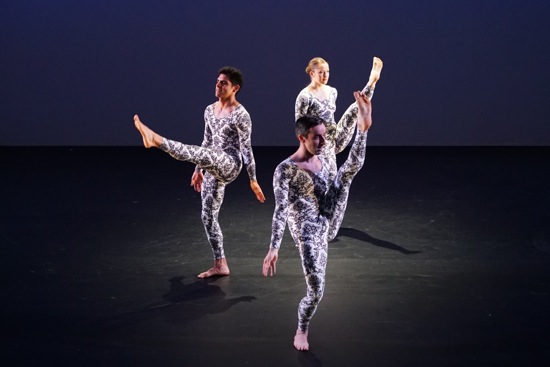
Mark Morris’s A Forest. (L to R): Domingo Estrada, Jr., Brian Lawson, Rita Donahue. Photo: Ani Collier
The program ended with The, but I’ve saved writing about the third work of the evening, A Forest, until last, giving myself time to compose my thoughts. This world premiere for nine dancers is set to Joseph Haydn’s Piano Trio No. 44 in E Minor. The composer was 65 and in London when he wrote it in 1797 for pianist Theresa Jensen (who, given the customs of the times, may never have played it in public). The first night of the company’s season the musicians happened to be all male: Georgy Valtchev (violin), Wolfram Koessel (cello), and Fowler (piano). The nine dancers (newcomer Nicole Sabella and apprentice Durell R. Comedy, Rita Donohue, Estrada, Lesley Garrison, Lawson, Stacy Martorana, Brandon Randolph, and Vinson) wear unitards designed by former company dancer Maile Okamura. The intricate black patterns on a white ground bring to mind fancy parlor wallpaper.
The first image is of the dancers grouped as trios in pools of light (lighting design: Nick Kolin) and moving to the staccato melody produced by the piano’s single notes and the violin’s synchronous plucked ones. Their arms are branching, but they are not exactly being trees. Instead the dance obliquely suggests the life of a forest with its animals and winging birds, streams, leaves and breezes, and the humans who make their way through life’s underbrush.
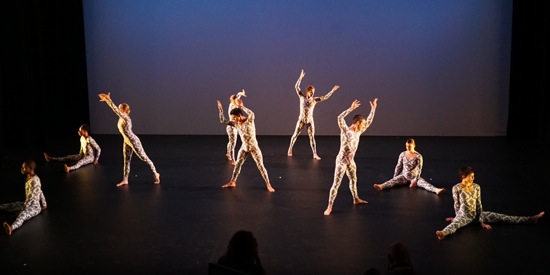
Mark Morris’s A Forest. (L to R): Brandon Randolph, Durrell R. Comedy, Lesley Garrison, Rita Donahue, Domingo Estrada Jr., Noah Vinson, Brian Lawson, Nicole Sabella, Stacy Martorana. Photo: Ani Collier
This is a curious group of people—nimble certainly: they prance, hop, jump, seem to perch, rush around. And for a few seconds, they do this with their hands over their ears. There are enigmas. Arranged in a V, they, one by one, drop (splat!) into a sitting position, with their legs spread. They upend into handstands. They jump teasingly and mince like naughty boys imitating foppish courtiers. They’re also gracious. They also swing their hips. Some pump their fists while others dance. A puzzling blackout intrudes between two movements (evidently for the dancers to re-group).
Morris has responded to the oddities and sudden changes of atmosphere in the music. In the first movement, the opening passage that repeats a number of times is full of contrast. That odd little unison duet between piano and strings; the same sweet melody embellished by the piano; suddenly assertive statements by the strings and the piano’s “oh no, really?” before it creates a fast-rippling stream to bear along whatever the strings have in mind. And so on. Morris, of course, doesn’t cleave to the music’s repetitions by repeating the same steps exactly. For instance, on one of several iterations of the opening, Vinson is dancing alone.
The second movement is labeled an allegretto, The piano’s low climbing and descending chords maintain a moderately fast walking pace, while less steady statements play on and within it. You could compare the effect to intermittent thoughts going through your mind while your feet take you along a path. The final allegro is boisterous romp in 6/8 meter. And to all this, Morris responds with his usual skill.
You can tell, I imagine, that I don’t yet know what to make of A Forest. I’m still lost in its mazy pathways. Maybe next time. . .
In all the evening’s revived pieces, plus this new, still settling-in one, the dancers perform superbly—ever musical, encapsulating the varied atmospheres and emphases that Morris, with their help, creates. I love watching them grow into the choreography and then grow some more. Grant and Michelle Yard have danced for Morris for twenty and almost twenty years respectively. Rita Donohue joined the company in 2003, Vinson in 2004. McMurray, Black, Laurel Lynch, and Jenn Weddel have racked up nine years each, Aaron Loux six.
This time, Estrada, a seven-year veteran, kept catching my eye. If I’ve counted correctly, he’s the only dancer who performed in all four works. But it’s not the frequency of his appearances that burned him into my mind. It’s the nuanced physicality and the musicality that he has developed. You sense him guiding one movement into the next—modulating it or shifting his focus without dropping the impulse with which he began. Wonderful!

This is, needless to say, lovely writing. And the description of what Morris does with the Milhaud fascinating to read about, especially in light of what Todd Bolender did with it in 1960 for New York City Ballet. He too includes simian movement in the beginning of the piece, but the world he is creating choreographically is New York in the roaring Twenties, transporting Adam and Eve from the Garden of Eden to the urban jungle. Nice work, Deborah, thank you.
Thanks for giving me a taste of a program I now really wish I could see right this VERY moment — especially the Bach and the new Haydn pieces. The Milhaud seems like something that Taylor would appreciate — I’d love to see that too — I”ve missed it somehow!. I so appreciate your effort to give a sense what the dances actually look like in movement-wed-to-music.
I’ve always felt the Brandenburgs are irresistibly “dancy” — I didn’t know that there were four hand piano arrangements of them. Could it possibly be Max Reger (not Regel) as it sounds like something he would definitely be interested in as an exercise. that would really be fun to play. Count on Morris to dig it out! I’d love to get a copy of the music.
Thanks so much for your response, Beth. And for pointing out my typo. Reger, of course! I hastened to correct it. The program was indeed a fascinating one. I wish I’d managed a second visit.
Writing almost as beautiful as the dance itself. Bravo, Deborah. True insight.